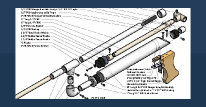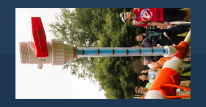
It's a 29-round stefanized drum.
This is what two of them are capable of doing:

On a 1-10 scale of difficulty, where 10 is a RevShot (yes, it goes higher, but I don't have any more complicated blasters to compare it to), I'd rate this as a 3. Yes, I think it's that simple.
---
Tools:
- Hacksaw
- File
- Needlenose pliers
- (Optional) 'normal' pliers: linesman, channel-lock, or slip-joint
- Boltcutters
- Hot glue gun
- Drill with fine ( ~1/16") and wide (~3/16") bits
- Long (8+" shaft) Philips-head screwdriver
- Knife, preferably a razor or box-cutter
- Sewing needle
- Sharpie
---
Supplies:
- CS-35 drum
- Reactor spring
- (5) 4" long x 1/2" dia hot glue sticks
- Wood screw 1/2" long by 1/8" diameter
- Washer with ID hole big enough to accept the above
- Lube
- Paper towel
- Duct tape
- Thread
- (8) foam blanks, appx 1.25" long
- Small screw eye, with shaft diameter approximately that of the drum's screws
- Zip-ties small enough to pass through the screw eye, above
---
To start with, take apart the drum.

Take a hacksaw to the clear piece as follows:
- There are three flanges protruding out the back. Hack them off, then file them flat.
- The part mating the straight portion of the magazine needs to go. Look closely at the picture to see how to hacksaw it off.
---
Drill out the three pegs. They're glued, so they are the enemy. We won't be needing either end, so use as large a drill bit as possible to ensure the upper portion is not touching the lower portion.

---
Break the tabs and notches. We won't be using them, so bust 'em if you have to.

---
Saw the sprocketed wheel off the half of the drum guts WITH THE NOTCHES, NOT THE TABS.

---
Using the pliers (any variety, though I used channel-locks for additional leverage and gripping strength), break off the six tabs.

--
Drill a hole across the spindle using the 1/16" bit.

---
Let's talk springs. We need springs with a COUNTER-CLOCKWISE twist if you look at the spring on end and follow the wire away from you. Or, looking at it front he side, the wire closest to you should be angled like this: /. The top and bottom springs are correct, the middle one is wrong.
All modern-generation Nerf Reactors I've opened have the correct spring. I'm calling this out because I do have that smaller Reactor-sized spring. It could have come from a BuzzBee knock-off, or an older-generation Reactor. Whatever the case, make sure you have the right spring. This is not optional, and using the wrong spring WILL NOT WORK.

---
Using the boltcutters, cut the spring ends off.

---
Thread it through the hole you just drilled in the spindle and, using the needlenose pliers, bend it back on itself.

---
Using the needlenose pliers, take the other end and bend the end first inward toward the diameter of the spring, then back out so you have an "N"-ish shape.

The truncated drum guts in the picture is already hot-glued together. DON'T DO THAT. These are the images I have, but in retrospect, you'll save yourself some headache if you glue the top part on later.
---
Drill a hole into the tabbed (and currently only intact) half of the drum guts.

---
FIRST run the wire into the intact drum guts, THEN hot glue it on.

This picture has an error in it. The reason for working the 'N' shape is to lock the wire to the spool. It should not have the crook visible.
Ah, hindsight.
---
One word about gluing the drum halves together: The notches do not have straight sides. Each is flared slightly inward. This means, if you align it so a wall is straight, the two wheels will be mis-aligned. Align it by the apexes of the notches not the walls.

---
Back to this picture. Use the long Philips screwdriver to collapse the spring in place. It has to be long to thread the spring, and it has to be Philips so it sits the spindle's hole.

---
Duct tape the INVERTED clear back over the whole assembly. Pay no attention to the chuck of hot glue. This picture is actually from a breakfix later on, but it works better in this part in the flow.

---
Add a drop (and just a drop!) of hot glue on the top of the spindle. While it is cooling, add some lube to the center top of the washer. It's okay if some lube gets on the bottom, but use the paper towel to ensure none is in the hole.

Not shown - use the Sharpie to mark which end is 'up' on the screw head. The center screw MUST NOT come undone. If it does, that coiled spring will become a Gordanian knot.
---
Thread the wood screw through the washer, ensuring no lube is on the screw, then drive it into the spindle throught the hot glue.

Rock the drum guts back and forth while the glue is drying to ensure it isn't glued down.
Again, pay no attention to the chunk of glue stick, out-of-sequence-picture, yadda, yadda.
---
Now for the straight portion of the magazine. We're going to do a lot of damage here. Remove the constant-force spring housing, breaking off the two guiding bars that go with it. Cut back the plastic until it's in line with the flanges that hold the straight part in the drum.
Next, take a file and file away half the width of the FORWARD guiding bar.

---
Hot glue three 4" long hot glue sticks together.

---
Apply hot glue to the top and bottom 1" of one 'end' of the three glue sticks and insert it into the straight part of the magazine so it is flush with the upper notch where the bolt travels. It will protrude slightly from the bottom. This is fine.

I don't have a good photo of it, so here's a shot from the prototype showing what I mean. Note that this one was glued from top to bottom of that block of hot glue sticks, which interfered with the magazine catch, so I had to take a file to it.
---
NOW we talk about that pesky rod of hot glue. Cut off a length of hot glue about 1.25" long. Wind the drum in a clockwise direction until spring is taut. Unfortunately, the amount of turns will vary with how much drag you have, which in turn is dependent on the thickness of your foam to the 1/100" of an inch.
Holding the drum wound tight, glue it so it is flush with the BACK part of the drum. DON'T glue it flush with the front part, because there are inner flanges in the front, so it will catch/drag.

Hold it until the glue is hard, then gently allow the drum to rotate until it gently comes to rest against the notch that holds the straight part of the magazine.
If you find that the tension is incorrect, you can adjust it by removing the straight part from the drum, then gently winding or unwinding the drum by working the glue stick past the protruding part.
---
Using the needle and thread, make a 'belt' out of the eight foam blanks.

It's a good idea to differentiate the blanks used as the follower from ordinary darts.
---
Replace one of the two screws holding the straight part of the magazine with the small screw eye.

---
Assemble it. You'll need to gently wiggle the guiding bar over the outer wheel. Zip-tie the straight part of the magazine in place.
Wind the drum so the glue stick is to the left of the inner protrusion of plastic that holds the straight part of the magazine. Insert the 'belt' of foam blanks in front of it, then load the drum. You should be able to get ~20 darts in there.
Hold the drum upright (so the darts don't flip) and gently allow it to advance until a dart is in firing position. Next, wind the drum slightly and insert a dart. Repeat 9 times.

Lastly, insert the clear part, inverted. You'll note that it will catch under the glue sticks. Use a piece of duct tape to keep it from flapping open. Double back the last 1/2" of the duct tape so it's easy to remove for loading.
---
To store it, wind it slightly and insert a piece of CPVC in firing position.

---
That's it!
Thoughts / comments / questions / flames?
Here are some of mine:
- I'd gladly sacrifice the 6 shots for the ease of not mucking with the follower, taking the straight part apart to add rails, etc.
- This allows you to see how many shots you have.
- Loading is much easier than a stock CS-35. You can load 20 darts w/o having to feed them through the straight part of the magazine.
- No SPACERS!
- Downside - your dart length has to be 1.5" or less. My Tuff-Cap V2s are 1.75" and won't work.
- If you have hotter climes, use high-temp hot glue.
- How close the hot glue rod is to the guiding bar is how many shots you have left.
- I've found that, once I've gotten the tension dialed in, it's 'pretty' reliable. Firing two drums fully, I got about two fail-to-advance failures (resulting in dry-firing) and one feed failure, which could have been due to a 'dirty' dart.
- Because my foam is a bit thicker than stock (mine measures 0.50", while a stock Streamline measures 0.49") I get a bit of drag. I've had to fire more slowly as a result.
===
BTW, huge THANK YOU to the admins for upping the picture limit!















